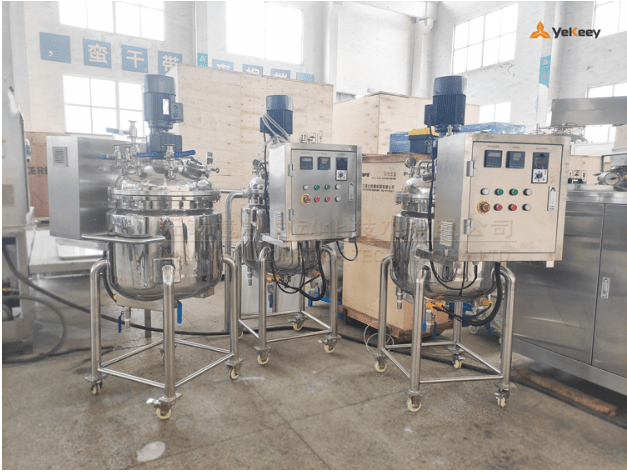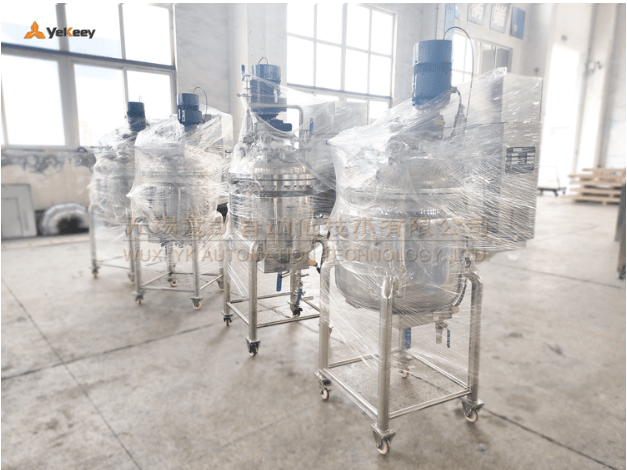A stainless steel stirring tank is a container used for stirring, mixing, homogenization, emulsification, and other operations. Its working principle is to achieve material stirring and mixing through the rotation of the stirring blade.
1. The following is the working process of the stainless steel stirring tank:
(1) Materials entering stainless steel stirring tank: Pour the materials that need to be mixed into the mixing tank.
(2) Start the agitator: Start the agitator and the mixing paddle begins to rotate.
(3) Mixing process: The rotation of the mixing blade causes the material to continuously flip inside the tank, achieving mixing and mixing of the material.
(4) Stop stirring: After stirring is completed, stop the operation of the mixer.
The stirring effect of a stainless steel stirring tank depends on factors such as the form of the stirring blade, stirring speed, and tank size. When selecting a stainless steel mixing tank, it is necessary to choose a suitable mixing tank based on the specific mixing task.
2. Next, the stainless steel stirring tank manufacturer will introduce to you the types and functions of classic mixing tanks!
Here are some common types of stainless steel stirring tanks:
- Liquid liquid stirring tank: used to stir a mixture of two or more liquids, usually with a higher stirring speed and a lower stirring blade angle to ensure sufficient mixing between liquids.
- Solid liquid stirring tank: used to stir a mixture of solids and liquids, usually with a lower stirring speed and a higher stirring blade angle to ensure uniform dispersion of solids in the liquid.
- Reaction kettle: A stainless steel stirring tank used for chemical reactions, usually with good sealing and corrosion resistance to ensure the safety and stability of the reaction process.
- Emulsification tank: A stainless steel stirring tank used for emulsification operations, usually with a high stirring speed and a low stirring blade angle to ensure the filling of oil-water mixtures emulsification .
- Homogenization tank: A stainless steel stirring tank used for homogenization operations, usually with high stirring speed and high stirring blade angle to ensure sufficient homogenization of materials.
- Dispersion tank: A stainless steel stirring tank used for dispersion operations, usually with a high stirring speed and a low stirring blade angle to ensure sufficient dispersion of solids in the liquid.
The types and functions of these stainless steel stirring tanks vary, and when selecting, it is necessary to choose the appropriate mixing tank based on the specific mixing task and application environment.
3. How to choose a stainless steel stirring tank?
When choosing a stainless steel stirring tank, the following aspects need to be considered:
- Tank size: Select the appropriate tank size based on the volume and shape of the materials to be processed.
- Mixing speed: Mixing speed is an important factor affecting the mixing effect, and the appropriate mixing speed should be selected based on the specific mixing task.
- Mixing blade form: The form of mixing blade has a significant impact on the mixing effect, and the appropriate mixing blade form should be selected based on the specific mixing task.
- Sealing: The sealing of the mixing tank is very important, and a mixing tank with good sealing should be selected to avoid material leakage.
- Material: The material of stainless steel mixing tanks should be selected according to the specific application environment. For example, 304 stainless steel is usually chosen in the food industry, while 316 stainless steel is usually chosen in the chemical industry.
- Manufacturer: Choosing a well-known mixing tank manufacturer can ensure product quality and after-sales service.
After understanding the above knowledge, you can choose a suitable stainless steel stirring tank for yourself!









I simply could not go away your web site prior to suggesting that I really enjoyed the standard info a person supply on your guests Is going to be back incessantly to investigate crosscheck new posts.